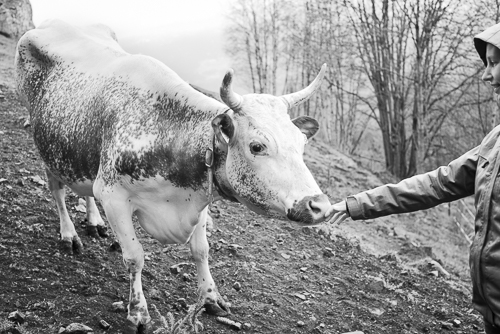Having already bought delicious cheeses from Rueslåtten farmhouse dairy at the local farmer’s market, I presented “slow pix” to Jarle Rueslåtten at the next farmers’ market and he agreed to let me visit him and his family near the village of Hagafoss. There, they live in a house overlooking meadows, the Halling valley and snow-covered mountains on the other side of the valley.
Upon arrival after about three and a half hours, Jarle invited me to join him and his cohabitant Rakel for lunch where we were served their own dairy products, amongst others a well matured cheese slowly turning into liquid. As expected, Jarle told me that a well matured cheese is a good cheese.
None of them grew up on a farm, but Jarle’s mother had grown up on Rueslåtten and he had spent many happy summers there. Having reached adulthood and graduated from a farmers’ college, he and Rakel continued managing the farm, which had been run by two of his uncles until about 2006. Having taken a cheesemaking course run by the indefatigable Pascale Baudonnel in 2005, a French-woman who has taught many Norwegian farmers how to make dairy products, at Sogn agricultural and horticultural school, they started making cheeses for sale in 2013.
After the hearty lunch, we entered the farmhouse dairy which, for obvious reasons, was located in the same building as the barn housing their 16 cows together with some calves. Inside the dairy, lots of cheeses were maturing in cool and humid conditions, while various tanks and types of machinery were not in use since it was a Sunday. Besides making cheeses from the milk from their own cows, they also buy milk from a local goat farmer, enabling them to produce goat’s cheese as well.
The following cheeses are produced at this farmhouse dairy:
- Chev Kubbe – goat’s cheese shaped like a small log.
- Kubbeost – round soft-ripened cheese covered in a white mould.
- Lord Garvagh – named after Lord Garvagh and his son. The father was hunting and fishing in Norway from the 1860s onwards and he built several hunting lodges in the mountains. His son hired a local man, Lars Leine, to build another hunting lodge, which is called Lordehytta.
- Salad ost – a type of feta cheese.
- The following cheeses are smear-ripened:
- Mjuk Halling – soft cheese.
- Vesle Velten – small, cylinder-shaped, firm cheese.
- Store Velten – big, cylinder-shaped, firm cheese weighing about 13-16 kg.
All of these cheeses are inspired by mainly French cheeses, but Jarle and Rakel also want to make traditional, Norwegian cheeses. In particular, they want to start producing a cheese called gamalost, meaning old cheese. As described in this article, gamalost is good for your heart. Fortunately, the aforementioned Pascale Baudonnel also advises those who need help with developing new cheeses via Norsk Gardsost.
Note that all of the cheeses made at this farmhouse dairy are not pasteurised and not homogenised.
After our visit to the farmhouse dairy, we went outside in order to have a look at the cows, consisting of 3 races: Telemark cows, Jersey cows and Norwegian Red.
Spring has been cold and late this year and the grass on the hilly and stony terrain just above the farm was quite short. Since it was also raining, the cows preferred to go to a rack loaded with hay, but Rakel told me that they really preferred to get inside instead of staying outside in the rather cold weather.
In summer, the cows are brought to a mountain farm where they keep meadows from being overgrown by trees and bushes. In fact, Jarle and Rakel are renting a mountain farm which is located about 75 minutes away, but they have bought another one much closer to their farm. After having rearranged it according to their wishes, they will let their cows stay there instead.
A popular science article in Norwegian shows that mountain plants contain a high level of antioxidants, antibiotics, natural flavouring substances and pigments. When the cows eat mountain plants, their milk will have a high level of antioxidants, a more healthy distribution of fatty acids, while the high level of pigments make dairy products yellow. Besides, it’s good for the cows having a varied diet, the cultural landscape is kept open and it also breaks up the daily routine of the farmers.
The rest of the year, the cows eat grass and hay together with concentrated feed. The amount of hay grown at Rueslåtten is not sufficient to feed the cows such that they also buy hay from their neighbours. Since winter is quite long, the animals are also fed concentrated feed, but with as much local content as possible since Rakel and Jarle want to avoid importing feed for their animals as far as possible.
The cows are artificially inseminated by veterinarians, while the farmers themselves take care of births of calves.
Besides producing various types of cheese, piglets are raised at Rueslåtten from spring to autumn. Then, they are slaughtered and turned into pork and ham. It’s also possible to buy veal from the farm.

